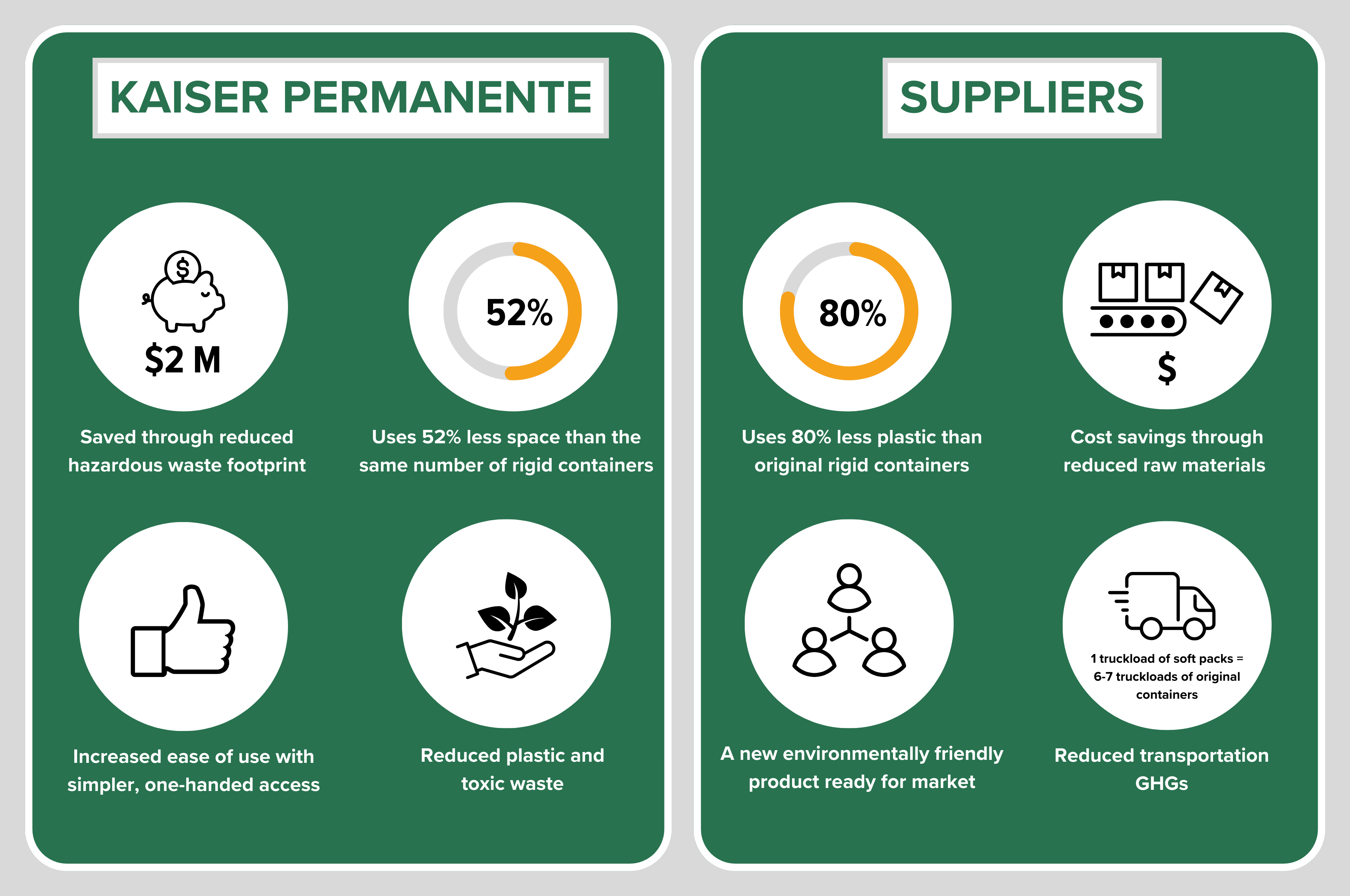“By working collaboratively, it is possible to drive innovative solutions to reduce the environmental footprint of health care, while also reducing costs for both suppliers and purchasers.”
– Elizabeth Eldridge, Kaiser Permanente director of sustainable sourcing
|
KEY TAKEAWAYS
|
The challenge
Hospitals produce more than 5 million tons of waste each year – and a huge portion of it comes from single-use plastics. In the state of California, disinfectant wipe containers with residual liquid must be collected as hazardous waste, with a disposal cost of approximately $5.75 per canister. Kaiser Permanente uses a large volume of disinfectant wipes annually, resulting in a large volume of costly hazardous waste. Kaiser Permanente recognized this challenge as an opportunity to leverage their purchasing power and influence their suppliers to collaborate on a packaging redesign that would reduce waste and save money.
Ready to collaborate with your suppliers?By working collaboratively with health care suppliers, the health sector can decarbonize and build climate resilience within the supply chain. Learn more about supplier-provider collaboration in our roadmap for action, published in partnership with Kaiser Permanente and Accenture. If your health system is looking to discuss sustainability collaboration with suppliers, the Climate Excellence Standard for health sector suppliers is a great resource to kick-start a conversation. |
The solution
Kaiser Permanente tasked their major suppliers with re-designing product packaging to allow for full use of the product with no residual liquid so that the leftover packaging could be discarded through a normal waste stream.
Implementation process
Kaiser Permanente’s environmental services and waste management teams coordinated with the system’s two major suppliers to initiate the packaging redesign effort. During the multi-year project, the Kaiser Permanente team and the suppliers worked closely to make sure the new packaging met quality and performance standards as well as applicable regulatory requirements. The redesign was an iterative process. They piloted sample packaging and collected user feedback.
The new packaging, which resembled soft baby wipe packaging, required minimal staff training and required minimal reconfiguration for product wall mounts in the facilities. The labeling on the new packaging was specially designed to avoid confusion with skin or baby wipes, addressing a concern raised during the feedback process. Since the initial packaging redesign and implementation, additional canister wipe products have been transitioned to soft packs. The project team is continuing to look for other redesign opportunities.
Buy-in and early successes
Early in the process, the stakeholders established how the packaging redesign could be a win for both Kaiser Permanente and the suppliers. The suppliers were able to achieve savings through a reduction in their plastic use, while the health system was able to achieve savings through a reduction in their hazardous waste footprint. Secondary benefits of the new packaging included reduced space needed for transportation and storage of the newly packaged products, reduced life-cycle greenhouse gas emissions, and increased ease of use. The team believes the collaborative process could easily be replicated for other product packaging.
Insights
The initiative was successful because Kaiser Permanente had a very clear ask and alternative packaging existed. While there were challenges along the way – like the fact that the new packaging from one supplier ran on the same production line as other retail products, so there was a cost and a conflict to ensure production line access – they were resolved over time. One lesson learned was that transitions always take longer than initially expected. Pandemic shortages and supply chain issues slowed access to and adoption of the redesigned soft packs, as did existing contractual commitments for the original product canisters.
The results
The redesigned soft packs allow for the complete absorption of the disinfectant liquid, thus eliminating the need to dispose of the used containers in the hazardous waste stream while maintaining compliance with hazardous waste regulations. The redesigned soft packs have resulted in more than $2 million in cost savings for Kaiser Permanente. The reduction in the size of the new packaging leads to a lower volume of overall waste generated, reducing the environmental impact of the health system.
Additionally, the redesigned soft packages proved easier to store in the system’s facilities, taking up 52% less space than the same number of rigid containers. Further, the soft packs provide simpler one-handed access, increasing ease of use.
The system’s suppliers have experienced cost savings as well through reduced plastic raw material usage. According to one of the suppliers, the redesigned packaging uses 80% less plastic than the original rigid containers. There was also a smaller distribution carbon footprint, with one truckload of the soft packs being equal to six truckloads of the original containers. The suppliers from now on will produce a more environmentally friendly product. This product will continue to be purchased by Kaiser Permanente – and is available to other health systems.

About Kaiser Permanente
Kaiser Permanente is a large, not-for-profit, integrated health care provider headquartered in Oakland, Calif. Kaiser Permanente operates in eight states – Hawaii, Washington, Oregon, California, Colorado, Maryland, Virginia, Georgia – and the District of Columbia. As of March 31st, 2023, Kaiser Permanente had 226,539 employees and 12.7 million members. Care for members and patients is focused on total health, which includes the social factors that impact well-being such as having a safe place to live, nutritious food, and enough money to pay the bills. Kaiser Permanente also invests in the communities it serves, works to ensure equity and advocates for policies that improve health.
